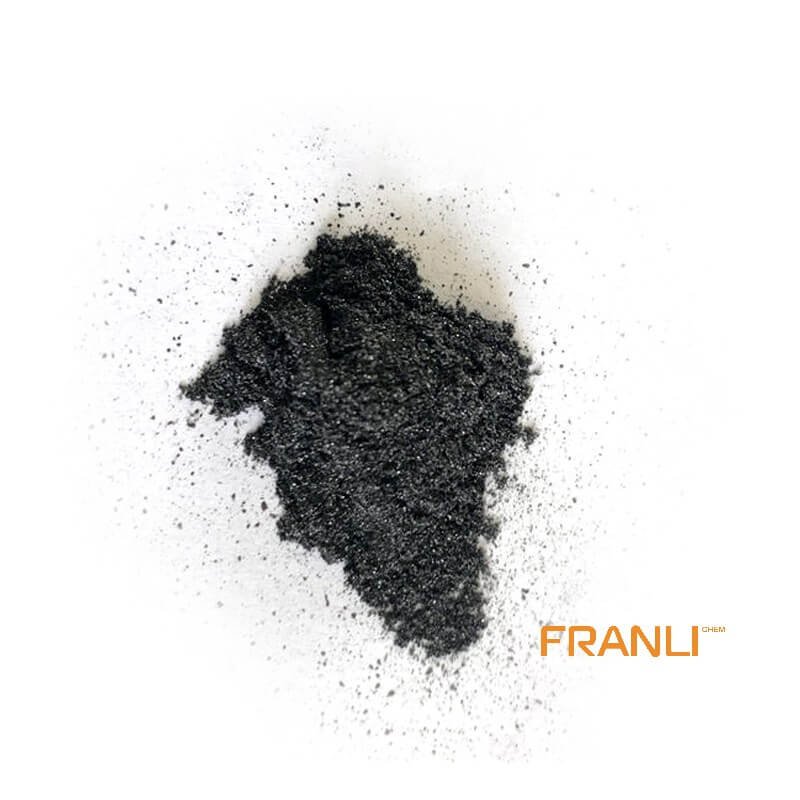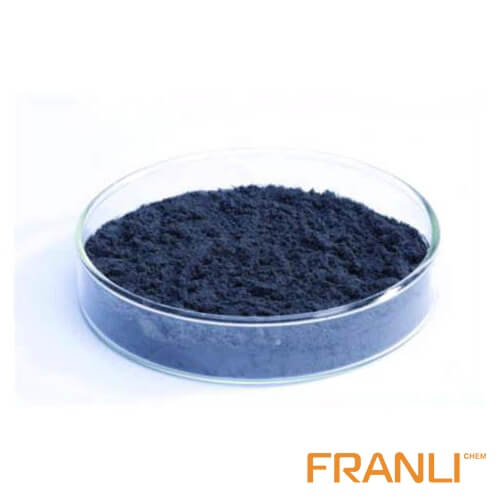


Expandable Graphite
Size
0.50mm or 0.106mm, etc
Package
25 kg small bags into ton bags
Origin
China
Features
Preservative/Electrical and thermal conductivity, etc.
Application
Fireproof sealing element, flame retardant, refractory brick, etc.
Expandable graphite crystal is a typical layered carbon material. Other heterogeneous particles such as atoms, molecules, ions, and even atomic clusters are inserted into the interlayer of crystalline graphite by physical or chemical methods to form a new layered compound, which is called graphite interlayer compound, namely expandable graphite.
Request a quote
Expandable graphite is used more and more in daily life, and expandable graphite has good performance and many applications. How to prepare expandable graphite is also what we need to learn.
The graphite crystal has a hexagonal network planar layered structure composed of carbon. The carbon atoms on the layer plane are covalently bonded with strong bonding force, while the layers are bonded with very weak van der Waals force, and the distance between layers is large. Therefore, under appropriate conditions, a variety of chemical substances can be inserted into the graphite interlayer and combined with carbon atoms to form a new chemical phase graphite intercalation compound. This kind of unexpanded graphite intercalation compound is expandable graphite.
When the expandable graphite is heated to an appropriate temperature, it can decompose instantaneously and produce a large amount of gas, which makes the graphite expand along the axial direction into a new worm-like substance expanded graphite. Exfoliated graphite maintains the molecular structure of flake graphite and is an allotrope of elemental carbon. The three adjacent carbon atoms form an SP2 hybrid orbital ° Because of the covalent bond, it has many properties such as heat resistance, electric conductivity, radiation resistance, corrosion resistance, and self-lubrication.

At the same time, expanded graphite also has the characteristics that natural graphite does not have, such as lightweight, porous, soft, compressible, and so on. Therefore, expanded graphite has a good application prospect in the chemical industry, electronics, environmental protection, and other fields. Especially, the infrared / millimeter-wave interference smoke agent and new broad-spectrum absorbing coating developed with expanded graphite as the main component can provide efficient soft defense passive jamming means for battlefield targets when applied to dual-mode stealth jamming bomb or stealth equipment, It is of great significance to deal with the attack of precision-guided weapons and ammunition and to improve the defense capability of important military, political and economic targets. Graphite has become a necessary mineral raw material for traditional industries and strategic emerging industries. It is listed as an important strategic resource by European and American countries, and its mining and technology export is strictly restricted.
How to prepare expandable graphite with high efficiency, high yield, and low energy consumption to make its product quality high and wastewater pollution low has become the focus of the current industry. Among them, the product quality is mainly considered from two aspects, one is the sulfur content of the product, the other is the expansion volume of the product. In addition, there is still room for improvement in the environmental pollution caused by the waste liquid in the production process. The traditional oxidation method mostly uses concentrated sulfuric acid, and the product contains high residual sulfide and is corrosive, which limits the large-scale application of the product to a certain extent. Therefore, the improvement of the production process should be focused on the improvement of oxidation technology.
It can be seen from Figure 1 that the expansion ratio gradually increases with the increase of nitric acid dosage at the initial stage, and gradually decreases after reaching the maximum value. This is because nitric acid has the function of oxidant as well as intercalation agent. When the amount of nitric acid is relatively small, the reaction between nitric acid and graphite is not uniform, and the intercalation and oxidation are not sufficient. When the amount of nitric acid reaches the maximum value (10ml), the oxidizability of nitric acid causes the peroxidation of graphite, and the expandable graphite and expanded graphite are finely broken, resulting in the decrease of expansion ratio.
The influence of phosphoric acid dosage on the expansion volume
Weigh 5g of graphite, add three beakers, then add potassium dichromate powder into the system, stir evenly, add 10ml of nitric acid in drops, and mix with 5ml, 10ml, 15ml, 20ml, and 25ml phosphoric acid respectively. The reaction was conducted at 50 ℃ for 60min after mixing evenly. After the reaction, wash to pH value of 4-5, filter, and dry for 4 hours at 60 ℃. Take out the sample to the nearest 0.001g, place it in a quartz beaker which has been burned in a high-temperature furnace at the specified temperature for 5min, immediately put it in a muffle furnace at 900 ℃ without closing the furnace door, and immediately take out after it does not expand, and read the volume of the sample after expansion.
It can be seen from Figure 2 that at the initial stage, with the increase of phosphoric acid dosage, the expansion ratio gradually increases, until the maximum value (phosphoric acid dosage 15ml), the expansion ratio begins to decrease. Phosphoric acid is used as an auxiliary intercalation agent to make the intercalation more sufficient and increase the expansion volume. However, adding too much nitric acid will reduce the concentration of nitric acid, resulting in the reduction of the expansion ratio.
Effect of potassium dichromate dosage on expansion volume
Potassium dichromate, as an oxidant, has strong oxidizability under acidic conditions. It can oxidize graphite and make graphite interlayer positively charged, which is conducive to the insertion of polar small molecules, negative ions and other intercalations. The amount of potassium dichromate has a certain influence on the expansion volume of graphite.
5g graphite was weighed at room temperature and added into a three-port flask. Then 0.2g, 0.4g, 0.6g, 0.8g, and 1.0g potassium dichromate powder were added into the system respectively. After stirring evenly, 10ml nitric acid and 15ml phosphoric acid were added dropwise. The reaction time was 60 min at 50 ℃. After the end of the reaction, wash to pH value of 4-5, filter and dry at 60 ℃ for 4H to obtain the expanded data.

It can be seen from Figure 3 that at the initial stage, with the increase of potassium dichromate dosage, the expansion ratio gradually increases. After reaching the maximum value (potassium dichromate dosage is 0.6g), the oxidant is excessive, the peroxide phenomenon occurs, and the expansion ratio decreases.
Effect of reaction time on expansion volume
5g graphite was weighed at room temperature and added into a three-port flask. Then 0.6g potassium dichromate powder was added into the system. After stirring evenly, 10ml nitric acid and 15ml phosphoric acid were added dropwise. The reaction time was 40 min, 50 min, 60 min, 70 min, and 80 min at 50 ℃. After the end of the reaction, wash to pH value of 4-5, filter and dry at 60 ℃ for 4H to obtain the expanded data.
When the reaction time is lower than the optimal value, the intercalation reaction is not complete. When the reaction time is higher than the optimal value, the intercalation reaction is excessive.
It can be seen from Figure 4 that at the initial stage, the expansion ratio increases with the increase of reaction time until the maximum value (reaction time is 60min), at which time the intercalation reaction is sufficient.
Effect of reaction temperature on expansion volume
5g graphite was weighed at room temperature and added into a three-port flask. Then 0.6g potassium dichromate powder was added into the system. After stirring evenly, 10ml nitric acid and 15ml phosphoric acid were added dropwise. The reaction time was 60 min at 25 ℃, 30 ℃, 40 ℃, 50 ℃, and 60 ℃. After the end of the reaction, wash to pH value of 4-5, filter and dry at 60 ℃ for 4H to obtain the expanded data.
It can be seen from Figure 5 that before 50 ℃, the expansion ratio increases with the increase of temperature, and after reaching the maximum expansion ratio, it decreases with the increase of temperature. This is because the reaction needs certain activation energy, the reaction rate is small when the temperature is too low, so the reaction can not take place fully in a short time. Because this reaction is exothermic, when the temperature is too high, nitric acid volatilizes and decomposes seriously, which not only reduces the concentration of nitric acid but also causes environmental pollution. Therefore, it is important to grasp the appropriate reaction temperature.
Test summary
In this study, the effects of nitric acid dosage and graphite ratio, phosphoric acid dosage and graphite ratio, potassium dichromate dosage and graphite ratio, reaction temperature, and reaction time on the volume of expandable graphite were investigated. The optimal conditions and ratio for the preparation of expandable graphite were obtained by analysis: reaction temperature 50 ℃, reaction time 60min, graphite (g), potassium dichromate (g), and graphite (g) The ratio of nitric acid (ML) and phosphoric acid (ML) is 5:0.6:10:15.



